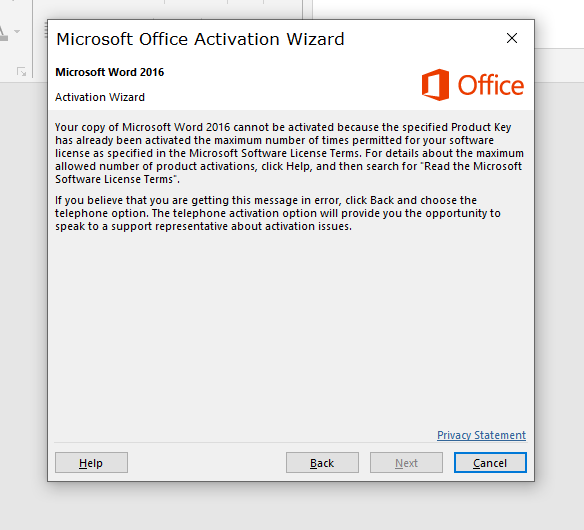Summary
This security update resolves vulnerabilities in Microsoft Office that could allow remote code execution if a user opens a specially crafted Office file. To learn more about these vulnerabilities, see Microsoft Security Bulletin MS15-099. Microsoft Office 2016 for Mac includes versions of Word, Excel, PowerPoint, OneNote, and Outlook that are designed for the Mac and yet are unmistakably Office. The September 15, 2015, update provides fixes for issues in the Office 2016 for Mac Suite (Word, Excel, PowerPoint, OneNote, and Outlook).
Note To install this update, you must be running OS X Yosemite 10.10 or a later version, and you must have a valid Microsoft Office 365 subscription. Additionally, see more information about Office 365 Subscription options. If you already have Office 2011 for Mac installed, you can run Office 2011 and Office 2016 side by side.
For a complete list of affected versions of Microsoft Office software, see KB3089664.
Open any Microsoft Office application. You can open Microsoft Word, Excel, PowerPoint, or Outlook. To access any of the Office apps on your Mac, click the desktop and click Go in the top menu bar, and then select Applications in the drop-down menu. Resolve Office 2016 AutoUpdate for Mac not Working. To download the latest updates for Office 2016, I needed to have AutoUpdate version 3.4 installed. If you have an Office 365 (or Microsoft 365) plan, you can provide your users with instructions on how to download and install Office for Mac for themselves. To install Office for Mac, a user has to be administrator on the Mac or know an administrator account name and password. I am experiencing a weird issue. We are trying to register an office for mac 2019, we insert the key into setup.office.com, download the installer and install it, and when opening word or any app for the first time, we are presented with a sign in window for activation. The user then enters their respective email address which they used when they created their office.com profile. The same installer package is used for Office for Mac and Office 2019 for Mac. How you activate the product determines whether you get the features for Office for Mac or the features for Office 2019 for Mac. Unlike Office 2016 for Mac, the installer package for Office 2019 for Mac.
Improvements and fixes
This update provides the following fixes and improvements:
Outlook
This update adds support for exporting data to Outlook for Mac archive files (.olm file format). Data is exported to an .olm file, where it can be archived outside Outlook for Mac and reimported to Outlook for Mac by using the Import .olm functionality.
Software updates including:
Fixes issue that caused invitations to displayed as off by one hour in Coordinated Universal Time
Improves attachment support
Improves reminders support
Meeting invitations always open to the maximum width of the screen
Printing the calendar in month view now uses the full page for better page use
Word
Software updates including:
Live word count in status bar is correctly updated when you change the selection
Scrolling improvements
Zoom level is preserved when a document is saved
Customized keyboard that has the ability to override default keyboard shortcuts
Excel
Software updates
PowerPoint
'Resume reading' now enables you to quickly return to the position at which you last edited a presentation
Software updates

Microsoft Office 15.3 For Mac Stalls Mid Updated
Applies to:Office for Mac, Office 2019 for Mac
Microsoft regularly publishes software updates to improve performance or security, and for Office 365 (and Microsoft 365) users, to update features.
As an admin, you can choose how to download and install updates for Office for Mac for your organization. You can do either of the following:

Configure Office for Mac to download updates automatically to users' computers, and then have the users install the updates themselves.
Manually download updates to your local network, and then use your software distribution tools to deploy updates to the Macs in your organization.
To update Office for Mac, a program named Microsoft AutoUpdate (MAU) is used. By default, Microsoft AutoUpdate automatically checks for updates daily, but you can change that to weekly, monthly, or manually.
If you decide to deploy updates by using your software distribution tools, you should configure Microsoft AutoUpdate to manually check for software updates. You can deploy preferences to configure how and when Microsoft AutoUpdate checks for updates for the Macs in your organization.
Individual security updates or other updates can't be downloaded and installed. Instead, Microsoft provides a new app bundle of an app, such as Word, that includes all the updates. As an admin, this means that you can't pick and choose which updates to install for a particular app, such as Excel. But, if you're doing manual deployments of updates, you can choose which apps you want to update. For example, you might decide to deploy the updates for Word and PowerPoint now, but wait to update Excel until you've had the chance to test that the updated version of Excel works with your line-of-business applications.
Microsoft Office 15.3 For Mac Stalls Mid Update Windows 10
Updates work the same for Office for Mac whether you have an Office 365 (or Microsoft 365) plan or you have a retail or volume licensed version.
Related articles
- Update history and release notes for Office for Mac
